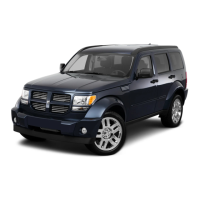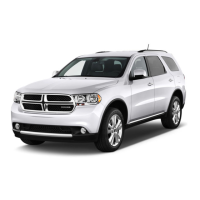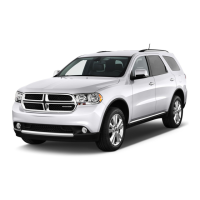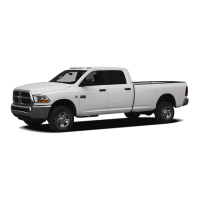Do you have a question about the Dodge 2011 Nitro and is the answer not in the manual?
This manual contains warnings against operating procedures that could result in collision or injury, and cautions against procedures that could result in vehicle damage.
Locates the VIN on the instrument panel and other vehicle locations.
Describes the double-sided vehicle keys and how they are enclosed with a key code number.
Details the vehicle's restraint systems, including seat belts and air bags.
Lists and briefly describes the components of the vehicle's air bag system.
Provides guidance on properly buckling children and using child restraint systems.
Offers essential safety advice for transporting passengers and general vehicle operation.
Explains the adjustment and function of the inside and outside mirrors.
Details the voice-activated, hands-free communication system.
Describes how to use voice commands to control various vehicle systems.
Covers seat adjustments, power seats, heated seats, and child restraint anchorages.
Explains the operation of headlights, parking lights, turn signals, and fog lights.
Details the operation and features of the cruise control system.
Describes the rear park assist system's sensors and warnings for obstacles.
Explains how to program the HomeLink system to operate garage doors.
Provides detailed explanations of the gauges and indicators on the instrument cluster.
Informs about the warning light for overheated engine conditions.
Explains the ESC activation and malfunction indicator lights.
Monitors various brake functions including fluid level and parking brake application.
Warns the driver of low tire pressure based on recommended cold placard pressure.
Details the required fuel types and octane ratings for the vehicle's engines.
Provides information on the fuse locations and descriptions within the power module.
Guides on adjusting the seat, mirrors, seat belts, and starting the engine.
Details the standard procedure for starting a cold or warm engine.
Explains the operation of the automatic transmission, including gear ranges and interlocks.
Describes the operation of the electronically shifted transfer case and its modes.
Provides advice for driving utility vehicles with higher ground clearance.
Covers general tire information, including safety, pressure, and markings.
Offers safety tips and information on trailer towing limits and definitions.
Provides actions to reduce potential for engine overheating.
Details safety warnings and instructions for changing a tire.
Provides step-by-step instructions for safely raising the vehicle using the jack.
Outlines the safe procedures for jump-starting a vehicle with a discharged battery.
Explains how to free a vehicle stuck in mud, sand, or snow using a rocking motion.
Describes how to temporarily move the shift lever if it cannot be moved from PARK.
Details procedures for towing a disabled vehicle using a commercial wrecker service.
Covers required maintenance services for optimal vehicle performance and reliability.
Provides instructions on checking and selecting the correct engine oil.
Explains the replacement and selection of the engine oil filter.
Details recommended service for the air conditioner system.
Guides on draining, flushing, and refilling the engine coolant system.
Lists fuse locations and descriptions for the Totally Integrated Power Module.
Outlines scheduled maintenance services for vehicle warranty and performance.
Lists the recommended maintenance intervals for various service items.
Details maintenance tasks for the 8,000-mile interval.
Details maintenance tasks for the 96,000-mile interval.
Provides tips for preparing for vehicle service appointments.
Guides on contacting authorized dealers and customer centers for help.
Provides contact information for the Chrysler Group LLC Customer Center.
Refers to the warranty booklet for terms and provisions applicable to the vehicle.
Instructs on how to report potential vehicle safety defects to NHTSA and the manufacturer.
Explains DOT tire grading categories for treadwear, traction, and temperature.
This manual contains warnings against operating procedures that could result in collision or injury, and cautions against procedures that could result in vehicle damage.
Locates the VIN on the instrument panel and other vehicle locations.
Describes the double-sided vehicle keys and how they are enclosed with a key code number.
Details the vehicle's restraint systems, including seat belts and air bags.
Lists and briefly describes the components of the vehicle's air bag system.
Provides guidance on properly buckling children and using child restraint systems.
Offers essential safety advice for transporting passengers and general vehicle operation.
Explains the adjustment and function of the inside and outside mirrors.
Details the voice-activated, hands-free communication system.
Describes how to use voice commands to control various vehicle systems.
Covers seat adjustments, power seats, heated seats, and child restraint anchorages.
Explains the operation of headlights, parking lights, turn signals, and fog lights.
Details the operation and features of the cruise control system.
Describes the rear park assist system's sensors and warnings for obstacles.
Explains how to program the HomeLink system to operate garage doors.
Provides detailed explanations of the gauges and indicators on the instrument cluster.
Informs about the warning light for overheated engine conditions.
Explains the ESC activation and malfunction indicator lights.
Monitors various brake functions including fluid level and parking brake application.
Warns the driver of low tire pressure based on recommended cold placard pressure.
Details the required fuel types and octane ratings for the vehicle's engines.
Provides information on the fuse locations and descriptions within the power module.
Guides on adjusting the seat, mirrors, seat belts, and starting the engine.
Details the standard procedure for starting a cold or warm engine.
Explains the operation of the automatic transmission, including gear ranges and interlocks.
Describes the operation of the electronically shifted transfer case and its modes.
Provides advice for driving utility vehicles with higher ground clearance.
Covers general tire information, including safety, pressure, and markings.
Offers safety tips and information on trailer towing limits and definitions.
Provides actions to reduce potential for engine overheating.
Details safety warnings and instructions for changing a tire.
Provides step-by-step instructions for safely raising the vehicle using the jack.
Outlines the safe procedures for jump-starting a vehicle with a discharged battery.
Explains how to free a vehicle stuck in mud, sand, or snow using a rocking motion.
Describes how to temporarily move the shift lever if it cannot be moved from PARK.
Details procedures for towing a disabled vehicle using a commercial wrecker service.
Covers required maintenance services for optimal vehicle performance and reliability.
Provides instructions on checking and selecting the correct engine oil.
Explains the replacement and selection of the engine oil filter.
Details recommended service for the air conditioner system.
Guides on draining, flushing, and refilling the engine coolant system.
Lists fuse locations and descriptions for the Totally Integrated Power Module.
Outlines scheduled maintenance services for vehicle warranty and performance.
Lists the recommended maintenance intervals for various service items.
Details maintenance tasks for the 8,000-mile interval.
Details maintenance tasks for the 96,000-mile interval.
Provides tips for preparing for vehicle service appointments.
Guides on contacting authorized dealers and customer centers for help.
Provides contact information for the Chrysler Group LLC Customer Center.
Refers to the warranty booklet for terms and provisions applicable to the vehicle.
Instructs on how to report potential vehicle safety defects to NHTSA and the manufacturer.
Explains DOT tire grading categories for treadwear, traction, and temperature.
| Brand | Dodge |
|---|---|
| Model | 2011 Nitro |
| Category | Automobile |
| Language | English |











